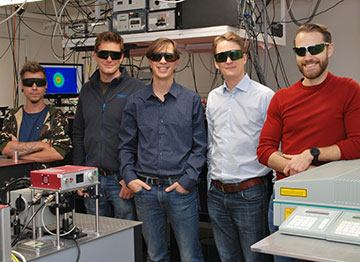
Lund University team (from left to right): Kristoffer Svendsen, Diego Guénot, Edouard Berrocal, Olle Lundh and Jonas Björklund Svensson. [Image: Edouard Berrocal, Lund University]
Atomizing sprays play many crucial technological roles, from dispensing fuel in internal combustion engines to creating documents with ink-jet printers. Whether a nozzle is spraying aviation fuel or industrial paint, engineers must optimize the droplet size and flow—a task made difficult by the tiny blobs’ ability to scatter visible light in multiple directions.
Scientists at a Swedish university have sidestepped the scattering problem by combining techniques: lasers and X-rays, absorption and fluorescence. The team split the beam from a laser-driven X-ray source and simultaneously measured an atomizing spray’s X-ray absorption and two-photon fluorescence (Optica, doi: 10.1364/OPTICA.378063). The dual method provides fine image details of the optically dense sprays that otherwise would get blurred and distorted with standard techniques.
Visualizing spray with X-rays
The researchers at Lund University, led by physicist Edouard Berrocal, studied the outflow of water, tagged with a fluorescent dye, from a commercially available fuel port injector with 280-μm-wide holes. In some of their experiments they added potassium iodide, which increased the droplets’ X-ray absorption.
The radiation for these experiments came from a tabletop laser-plasma accelerator developed by Lund physicist Olle Lundh and his colleagues. The laser emits 800-mJ, 38-fs pulses with a wavelength of 800 nm, which pass through the accelerator and generate X-rays between 1 and 20 keV—an ideal energy range for penetrating droplets roughly 100 μm in size. After passing through aluminum foil to block the laser beam, the X-rays cross the spray path, and any photons not absorbed are collected by a detector equipped with a beryllium window.
Researchers diverted some of that laser beam into a “light sheet” with a cross-section of roughly 2 cm by 100 μm. That light sheet was angled so the water spray would pass through it and create two-photon laser-induced fluorescence (LIF), recorded with a scalable CMOS camera equipped with a bandpass filter at 550 nm. Both detectors—for the X-rays and visible fluorescence—took pictures simultaneously.
The X-ray images provided the Lund team with a global view of the water jet, while the LIF-based images showed great detail in the sizes and shapes of the droplets. The researchers hope to tweak this technique to apply it to more challenging atomizing-spray conditions.
